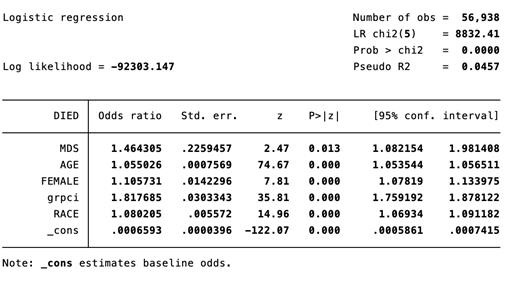Abstract
Introduction
Ischemic heart disease remains the single largest cause of death worldwide. In the USA, 365,744 deaths were associated to coronary heart disease, and the mortality is highest in population older than 65 years old. Myelodysplastic syndromes (MDS) also mainly affect this group age and studies suggest an incidence as high as 75 cases per 100,000 aged >65 years. In the following abstract we analyze the mortality rate in patients with MDS and STEMI.
Methods
We conducted a retrospective analysis of 3 years of National inpatient sample (HCUP-NIS) data base from 2016 to 2018. Patients older than 60 years old and with or without MDS were selected using ICD-10 diagnosis code. Principal diagnosis of STEMI was included with the code. ICD-10 procedure code was used for left heart catheterization. Discharge-level weight analysis was used to produce a national estimate. Continuous variables were compared by t-test, while chi-square and Fisher's exact test were used for categorical variables. Finally, multivariate logistic regression was used to calculate odds ratio for inpatient mortality and multivariate linear regression for length of stay using STATA 17 statistical software.
Results
A total of 45,724,104 admissions met inclusion criteria, of those, 210,780 patients (0.46 %) have MDS. Patients with MDS are more likely to be of older age (78.7 v 74.8, p <0.00001), male (56.4% v 46.7%, p < 0.0001) and white (81.0% v 76.0%, p < 0.0001). They are also associated with lower prevalence of diabetes (16.2% v 20.1%, p < 0.003) and smoking (0.4% v 0.8%, p <0.0001) but higher prevalence of peripheral arterial diseases (12.7% v 11.6%, p <0.0001). During the study period, a total of 1,293,994 patients were admitted primarily due to STEMI, 3,270 of these patients (2.5%) had underlying MDS. Out of the 3,270, only 1,105 (33.8 %) underwent left heart catheterization. On the other hand, 735,610 patients without MDS (57.0%) underwent percutaneous coronary intervention. After adjusting for age, sex, race, diabetes, and Charlson comorbidity index, there was a statistical significant in mortality (OR 1.46, CI 1.08 - 1.98, p < 0.013) and longer length of stay by 0.59 day (p < 0.0001).
Discussion
In our study, MDS is associated with higher mortality and loner length of stay. Peripheral arterial diseases are found to be more prevalent in MDS even though other cardiovascular risk factors such as diabetes mellitus and smoking are less prevalent. It is consistent with prior study, by Jaiswal S et al, hypothesizing that MDS is an independence risk of atherosclerotic cardiovascular diseases. Interestingly, patients with MDS are less likely to undergo left heart catheterization which is the definitive intervention for diagnosis and treatment of ischemic heart diseases. We recommend our hematology society to identify and treat the cardiovascular risk factors in these patients. Further studies will be required to develop a standardized evaluation and management plans for MDS population.
No relevant conflicts of interest to declare.


